-
TOP BRANDS
-
CURATED COLLECTIONS
Anatomy of a Watch
A mechanical watch can have 400 parts, but it’s how they come together that we love. The parts of a watch are vast, but with a quick watch anatomy lesson, you will know all the basics and a few extras of your luxury watch.
Watch Anatomy: How a Mechanical Watch Differs
So, you just bought your first luxury watch. It’s a bit different than the digital you were sporting, but you were ready for the upgrade. A Swiss timepiece can have up to 400 parts. These parts, or the watch anatomy, give it the aesthetic value that attracted you to the watch and also make it run.
You’ll want to be able to talk confidently about your watch, so it’s important to know exactly what went into your new timepiece. More than just being a beautiful piece of art on your wrist, these watches are functional, and even the most casual observer will notice the craftsmanship and work that went into it.
The Basics
So, here is a primer on the most basic parts of your watch:

- Bezel
- The bezel goes around the crystal of a watch are usually made of metal or ceramic.
- Bracelet or Strap
- These are the bands that secure a watch to a wrist. In order to be considered a bracelet, the band must be made of metal.
- Case
- The case is the part of the watch that contains the movement and dial. This protects them from normal wear and tear as well as the elements. They come in several different shapes and materials.
- Crown
- This is a knob on the outside of a watch case that sets the calendar and time. It also winds the watch.
- Crystal
- This is the transparent cover on the top of the dial or face. This is designed to protect the watch from dirt and water and reduce glare. The majority of modern Swiss timepieces have a sapphire crystal.
- Dial
- Also known as the face, the dial is the portion of the watch that displays the time. It can come in several different colors and marker combinations.
- Hand
- The hands are the markers on the dial that indicate time. Most watches have at least three hands to show hours, minutes, and seconds.
- Hour Marker
- These are the indicators on the face of a watch that mark out the hours.
- Lug
- These are projections on the watch case that secure the strap or watch bracelet to the case.
- Signature
- This is the manufacturers information on the dial of the watch.
The Extras
Each watch and manufacturer is different from the next and they all have their unique attributes. Now that you know some of the basic anatomy of your watch you can dive into some more of the intricacies and the pieces that make them unique:

- Chronograph
- A chronograph is stop-watch. The pushers on the side are a good indicator that a watch is a chronograph watch.
- Helium Release Valve
- This valve is for professional divers and helps release the trapped gas that builds up in a watch during prolonged dives of 250ft or more, specifically saturation diving.
- Luminosity
- Many watches have hour markers and hands that glow-in-the-dark. Watchmakers use a specific material to create this luminous effect. While luminosity is cool-looking, it also serves a function, allowing the wearer to see in murky or dark spaces like the deep water or night skies.
- Pusher
- This is an attachment to the case that would control the watches functions, such as a date adjustment or chronograph.
- Subdial
- Sometimes a smaller dial is inside the main dial. This is a subdial. It tells information that isn’t provided by the main dial, such as dates or seconds.
- Sweeping Seconds Hand
- Instead of jumping with every tick, a sweeping seconds hand moves smoothly across the dial or subdial. Most mechanical watches have a sweeping seconds hand.
- Tachymetre
- This is a feature on a watch that allows the user to measure speed. Some also allow the user to measure distance.
- Unidirectional Rotating Bezel
- This is the functional part of a dive watch that helps track air supply. It moves only in a counter-clockwise direction and as a result, helps a diver time how much air they have left in their tank.

- Exhibition case back
- The movement inside of a watch is pretty intricate and let’s face it, cool looking. An exhibition case back is transparent, so you can see the movement.
- Jewel
- These are small sapphires or rubies that act as bearings for the gears to help reduce friction. So they are in the movement of a watch.
- Movement
- This is the watch’s engine. Hence, it powers the watches functions and keeps its time, and is located within the case.
- Oscillating Weight
- For automatic watches, this weight uses gravity to help wind the watch. So, as a user wears it on their wrist, the watch continues to wind without manual intervention.
The above are some of the most common features and complications, as well as anatomy, you will see on a luxury watch. Most luxury watches were built to serve a particular purpose, but some just have great features, or complications, that although may not be super useful for today, still look really good.
Last, But Not Least:
These are other complications and watch features that we haven’t laid out above though they are still important.
- Aperture
- This is a small cutout window within a dial that indicates specific information other than time. This window can indicate dates, moon phases, or other information for that particular style of watch.
- Cyclops
- The cyclops is a small lens on the crystal of a watch and its purpose is to magnify the date.
- Moonphase
- Although this keeps track of the current phase of the moon including full, half, quarter, and new moon; sailors used it originally to gauge tides.
- Perpetual Calendar
- This is the most complex calendar available on a watch. It features the month, day, date, year, and even takes leap year into account.
- Power Reserve
- This indicates how much power is left in a watch. Some watches can have up to a 10-day power reserve.
Now that you have a basic idea of the parts of a watch, you may want to learn more about the brand of your luxury watch. Each of the luxury watch brands have their own unique attributes and history, paving the way for iconic models from each. Take a look at the brand guides to learn more.